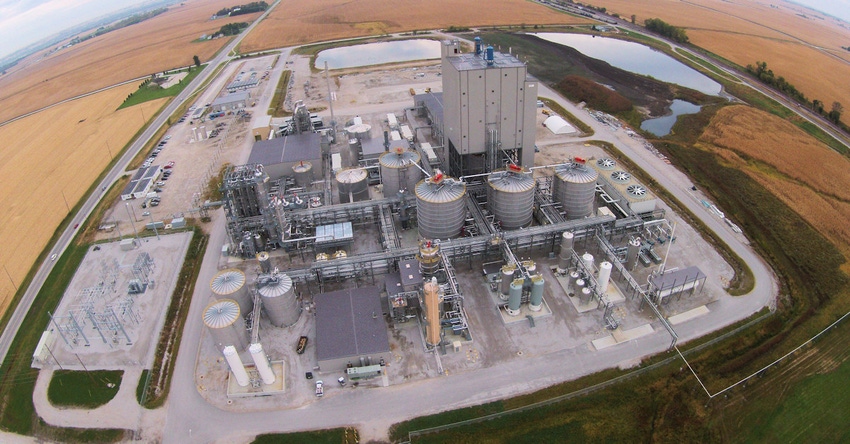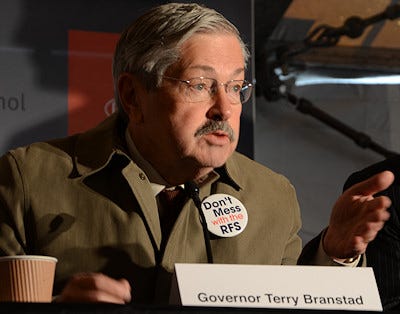November 5, 2015

The day before Halloween was a big day for Nevada, Iowa. That’s the day that DuPont officially opened its new cellulosic ethanol plant. Key dignitaries were on hand from the state and the company to mark the historic day.
DuPont’s plant, the largest in the nation, when up to full capacity will produce 30 million gallons of ethanol a year from corn stover. Jan Koninckx, global business director, Advanced Biofuels, DuPont, explains that fuel from this plant will be made generating “90% less greenhouse gas then the production of gasoline.”
Koninckx notes that the ceremony was being held ahead of the official plant opening, during the media event and tour he referred to the Nevada plant as “serial No. 1,” which means DuPont is doing something entirely new, and will gradually start up the process over time. “Plants two, three and four will start more quickly in the future,” he says, noting DuPont’s commitment to biofuels.
He adds that in the company’s 213 year history, it has brought many plants online. “We know how to bring a plant online, there’s always a degree of uncertainty in a first plant. We expect the first shipments of biofuel to begin in 2016.”
Renewable fuel standard
A challenge for the plant is current uncertainty over the Renewable Fuel Standard in Washington, an issue that brings the ire of Gov. Terry Branstad, a long-time champion for ethanol. His support for ethanol “goes way back” and he notes the petroleum industry’s continued adversarial position to the RFS, and ethanol in general.

Long a champion for ethanol (note the RFS button on his coat) Iowa Gov. Terry Branstad is concerned about the politics of the Renewable Fuel Standard in Washington. He says consumers should be given a choice.
“We’re not waiting for Washington,” Branstad comments during a post-event press conference. “We’re putting more blender pump in and giving consumers a choice of renewable fuels,” Branstad says. He notes that at blender pumps, when given a choice, consumers choose more ethanol. The price advantage for ethanol is usually about 40-cents lower than gasoline – though lower oil prices have sometimes narrowed the gap.
Sen. Chuck Grassley, who made the trip to Nevada in time for the event after a 3 a.m. vote very early that Friday morning in D.C., on the two-year budget measure, expressed his support, and ire, concerning how ethanol is seen. He notes that the Senate can take some action on the RFS, once EPA finally comes out with the rule including some legislative actions on funding the program. But where Grassley gets upset is over the “food vs. fuel” debate and the way media report the issue.
“They say 40% of corn goes into ethanol, but 18 pounds of that 56 pound bushel comes back out as animal feed, which means 27% of the corn crop is going into ethanol,” he says, and called on media to be “intellectually honest” about the issue.
Branstad adds that the food versus fuel argument was never right and was the oil industry’s “big lie” noting that the corn raised in Iowa is not the corn people eat, adding “when corn was $8 food went up, but corn is $3.40, have food prices dropped? The evidence is clear, [food versus fuel] is a false argument.”
Starting from scratch
The DuPont plant is not the first to make ethanol from biomass. Poet and Abengoa are both running plants that use a range of materials to make the renewable fuel, but the DuPont facility will be the biggest so far. And DuPont took a “clean sheet” approach to this plant bringing in some interesting innovations. Here’s a look at the process of making cellulosic ethanol in the Nevada plant and some of the innovations the company has brought to the process.
But first, why did DuPont get into this business in the first place? William Feehery, president of DuPont Industrial Biosciences offers three reasons:
“First we have the engineering to build this,” he explains. “Second we own Pioneer seed company and we view that not only as a seed company but also as a company that provides service to farmers, and keeping with that we relied on the agronomic experience of Pioneer. Finally, Industrial Biosciences division is one of the largest enzyme companies in the world and we have key technology on the enzyme to digest the cellulose and hemicellulose in the stover.”
He adds that DuPont didn’t have everything it needed, but combining its expertise with support of the local community and growers gave the company needed “critical mass” to proceed with the Nevada facility.
When you start with what Koninckx calls a “green field” approach, there’s complete control over the process. And this plant, the first of its kind for DuPont, and in many ways for the industry, was also thinking “green” from the start.
Take water, for example, the new plant essentially retains and uses all its water with zero loss other than evaporative cooling loss in some steps of the process. The old saw that ethanol plants use a lot of water is changing and in this facility while it may take water to make ethanol, it’s the same water over and over.
The process defined
Here’s a look at the process from field to fuel for the DuPont facility. And the first step is the arrival of corn stover. DuPont is working with about 500 farmers in a 30-mile radius to provide large square bales of material to the plant. Storage areas are spread out to better manage supply, and avoid issues with bales heating. In early setup on the way to getting the plant going, there have been some bale fires. The company has worked out systems of stacking and storing to avoid the problem.

A large square bale of corn stover will produce about 42 gallons of ethanol. Posing with the new biofuel source is Iowa Lt. Gov. Kim Reynolds, and Gov. Terry Branstad.
And it’s an issue, the plant will bring in 375,000 tons of large square bales – 3x4x8-1/2 feet – and go through about one each minute to keep the plant running. Each of those bales can produce about 42 gallons of ethanol.
Bales enter the facility and where they are opened up and the material is ground into smaller pieces where they then pass through a pretreatment process using ammonia to start the break down process that allows enzymes to get into the cell and create complex carbohydrates.
Those enzymes are the key to releasing the lignocellulose in the biomass, and Koninckx explains that DuPont is constantly researching enzymes. What the plant starts with today could change as more efficient materials are developed. The DuPont-developed enzymes are added to the lignocellulose and they break down the complex carbohydrates into simple sugars for fermentation.
On a side note, when you open up a corn kernel and release its sugars in the ethanol process, you get glucose. Do the same thing with biomass and the result is a blend of different sugars, which also makes the process more complex.
Once you have the sugars the next step is fermentation. And here DuPont is innovating versus what other biomass plants are doing. In those plants, yeast is the main fermentation promoter, but not in this new plant. Koninckx explains that with yeast in a traditional ethanol plant you get added material and of course you want the DDGS to market, but not in a cellulosic plant.

The DuPont facility has settled on using only large square bales, to maintain efficiency in its process. All material handling is constructed around a consistent bale size. In fact, off square bales will be rejected early in the process.
DuPont has turned to a proprietary microorganism to do the job. In fact they’re using Zymomonas mobilis which has long been studied as a potential player in the biofuel market. And now DuPont is putting it to work. This material can ferment the sugars to create the needed alcohol, and just like yeast, it can be engineered for enhanced efficiency.
Once fermentation is complete, and the company has three one-million-gallon fermentation tanks on site that will help create a continuous process, the fermented material goes on to distillation, which essentially separates the ethanol from any water to create pure product.
The fuel-grade ethanol is moved to storage where it is later shipped out to be blended with gasoline. The fuel created at the Nevada plant is heading to California where the state has a Low Carbon Fuel Standard, which this new fuel meets. But DuPont is also looking at other ways to cellulosic ethanol including licensing the technology to other companies – including a Chinese company that plans to build that country’s largest cellulosic plant. Even the folks at Proctor & Gamble are interested in using the ethanol for Tide laundry detergent.
About the lignin
The cellulosic plant does have a byproduct that’s different from what you get in a traditional ethanol plant, and it’s the lignin from the plant material. This material is contained in the stillage left over after the distillation process.
That material is filtered, conserving the water, to create a high-lignin granular material that can be sold to coal-burning power plants. Koninckx says the material has the same BTU heat energy as traditional coal, which means your local cooperative coal-fired plant could be burning material from corn fields in the future too.
It’s not often that a person gets to be around when history is made, but in Nevada, Iowa, that’s what happened last week. This new plant will provide ethanol into the market, but it’s not the last one DuPont will build.
About the Author(s)
You May Also Like






